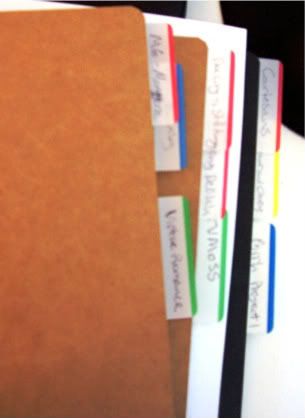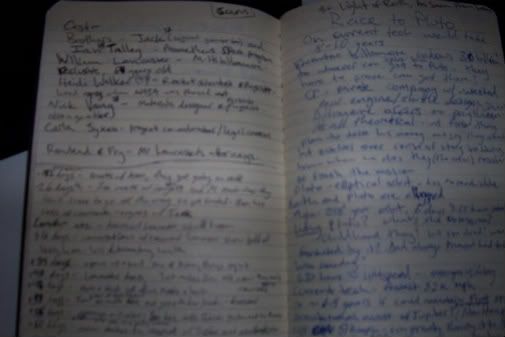In the comments on the last post (about 2011 goals), one of the comments asked about my system for keeping track of ideas. I do, in fact, have a system, though like most systems that have organically grown over the course of time, it doesn’t necessarily make a ton of sense. I figured I could do a post on it, but I’ll add some visual aids just for fun and try to describe how the parts I couldn’t figure out how to get visuals for work.
So let’s follow an idea from inception to finished product/submission through my recording system. The first thing that usually happens is a character or bit of story or a line or two pops into my head. From there I let it sit. If, after a couple days (or when the idea is super insistent), I still have it in my head, then I write it down in a notebook. Yes, a good old paper notebook. I use Moleskine Cahier notebooks because I love the way they feel and how well they hold up. This is probably a hold-over from when I used to write every story by hand (something I did up until a few years ago when I tried to write a novel by hand and pretty much said fuck that).
If the idea has a title, I use the title to list it (each idea gets a fresh page). If it doesn’t yet I just pick out a couple key words. This is the beginning for both short stories and novels. If I know that the idea is probably going to be a novel idea, I make a note of that on the page. I have multiple notebooks for ideas. In the past I was just sort of filling them up as I had the ideas, but for next year I’ve actually gone and separated out a notebook for novellas, one for short fiction, and one for novel ideas. I’m not sure how long that level of organization will last since sometimes I don’t know if an idea is a novel or just a short one at the start (they tend to seem like they’ll be short, but then grow and get more complex).
From there the ideas sit until I’m ready to start on them. At that point they have different fates. Novel ideas get their own sections of a different notebook. I give you exhibit A:

These are a few of my novel project notebooks. Some of these novels have been written or are in various stages of writing (There’s actually a notebook without tabs in there, but it’s dedicated to a trilogy, so I didn’t tab it yet since I know which one it is, so this picture represents 11 novels and 4 short novels). Inside these notebooks I outline, keep track of character descriptions and place names, and do all the little nitty note taking that I feel is necessary to keep track of the world for each of my novels. I imagine that when I start actually writing multiple series books that I’ll gravitate toward having a single notebook for each series with my handy tabs dividing by book, but for now this system allows me to easily flip to whichever project I want to work on and to see which notebooks hold which novel at a glance. I find this simpler than trying to use electronic notes, though I appreciate that if anything ever happened to my home (fire, flood, really bored thieves), that this system could fall apart. At least I back up all the actual writing electronically in multiple places.
So that’s what the novel notebooks look like. For short stories I just find the title/tag line of the story I want to work on (if I’m in a short story writing mood I generally flip through until I find something I want to write), and then I just continue with story notes and character descriptions and all the things I need to keep track there. Which, once a story is done, generally leaves me with a couple of pages that look like this:

If you can read my handwriting at the top of the right page there, you’ll see that this story was originally tagged as “Race to Pluto” but then got its actual title “The Light of the Earth, as Seen from Tartarus” once I’d started working on it more. (This story has already been through Writers of the Future, so I’m using it since I don’t have to worry about anonymity anymore). I generally write short stories over the course of a single day, sometimes two (this one took two, but it’s 13,300 words long). I don’t often outline short stories, but as you can see from the left page above, I did a rough time line because the timing in this story was important (And yes, I do have the crazy handwriting of a serial killer, but *I* can read it, usually). Sometimes though I’ll be adding notes and ideas to a page for weeks before I get working on a story. It all depends how long the story needs to percolate in my brain.
The next step is once I’ve decided to work on a story or novel. I go into my writing folder and then into the relevant folder (Short Stories or Novels or Novellas). Then I make a folder with the title of the story or novel. Then I open a word document and label it as a rough draft (usually titleRD.doc) and go to work. Recently I’ve expanded this system a little. I don’t normally start short stories and then not finish them, but back in October I was working on hooks and beginnings, so I picked out a bunch of short story ideas from my notebooks and went to the next step without finishing. So in my short stories folder I have a folder called AAAbeginnings (the three a’s are so it will sit at the top of my alphabetized sorted list). In there I keep the folders of stories that aren’t done (I have quite a few at the moment thanks to that exercise). Once I finish a story out of that folder, it gets moved to the regular section.
I also have a few pages in one of my notebooks that is all titles. Pages and pages of titles that don’t have an idea attached. Last year I decided I was pretty terrible with titles and wanted to practice coming up with them. So I tried a few different methods (ranging from putting random words together to using random title generators on the internet) and wrote down all the ones I liked. So sometimes if I have a story idea I’ll scan those pages of titles and see if any fit or can be altered to fit.
Anyway, that’s how my system, such as it is, works. I have tons and tons of ideas, more than I will ever likely be able to complete. And more come in each day (I think I have about 15 notebooks in various stages of full at this point). It’s one of the main reasons I’d like to be faster and more consistent, because then I’d get a lot more of these ideas developed and out to markets. So hopefully this post helps show how the hell I keep track of all this. I imagine my system will keep evolving to suit my needs and career, but for now it works for me.


